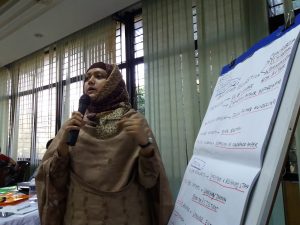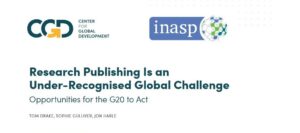
Improving the journal publishing environment of Bangladesh – Part 2: the roadmap
In the second part of a two-part article, Haseeb Md Irfanullah continues to talk about how organizations from the North and the South can be brought together to change the face of academic publishing in Bangladesh through inclusive, long-term planning and how this will help Bangladeshi journals meet the new Journal Publishing Practices and Standards (JPPS) levels that are being developed by INASP and African Journals Online.
The first-ever ‘BanglaJOL Dialogue’ in December 2016 was an opportunity for thorough discussions on international journal publishing standards and the challenges that hinder Bangladeshi journals in attaining them. This discussion helped the participating editors to understand the current journal publishing environment of Bangladesh and so begin to draft a ‘Roadmap’ aimed towards improving the standards of Bangladeshi journals over a specific timeframe and meeting the requirements of the soon-to-be-published Journal Publishing Practices and Standards (JPPS) levels.
In the weeks following the Dialogue, I developed a complete draft of this Roadmap as decided in the event. This Roadmap is essentially a list of ‘positive changes’ the BanglaJOL editors want to see in their journals. Each change is accompanied by a list of possible actions to be taken by these journals or concerned authorities, as well as by a timeline for carrying out these changes.
A total of 12 changes have been listed in the draft Roadmap, namely i) Journals are published regularly and on time; ii) Journals are indexed by reputed agencies; iii) Journals have Impact Factor (preferable issued by Clarivate Analytics (formerly part of Thomson Reuters) Journal Citation Reports); iv) Submission of quality manuscripts increased; v) Journals are more international; vi) Editorial Boards are more active and effective; vii) Sufficient number of good reviewers submit comments on time; viii) Journals practise publishing ethics to the fullest; ix) The language is better in published papers; x) An editing helpdesk is established and helps BanglaJOL editors; xi) ‘Bangladesh Journal Watch’ is established for journal quality monitoring; and xii) ‘National Science Journal Publishing Policy’ formulation has started with the Ministry of Science and Technology.
As it appears, a few of these 12 changes very much depend on several other changes. For example, ‘Journals are published regularly and on time’ depends on regular flow of quality manuscripts, a quicker peer-review process, and an active Editorial Board and journal office. It also has major implications on a journal’s indexing and Impact Factor.
To explain how each change is translated into actions, with responsibilities and deadlines, let me give two examples very much appreciated by many developing-country journals. To increase the submission of quality manuscripts, four actions are proposed, namely i) Invite potential authors via professional contacts, emails, social media, and international conferences (This should be started immediately and should continue until a sufficient flow of manuscripts is sustained); ii) Update and upload clear ‘Guidelines to Authors’ on the BanglaJOL website describing expected quality of the submitted manuscripts (This should be completed by June 2017); and iii) Shorten the manuscript processing time (This should be started immediately as a continuous process).
In terms of responsibility, all these actions should be led by the respective Editorial Boards. The final action point is organize at least one training session per year for local scientists on how to write quality papers and different aspects of publishing in peer-reviewed journals. The first one should be conducted by October this year, and then every year, by professional societies, the Bangladesh Academy of Sciences, or INASP.
[One way to address this would be to encourage authors in BanglaJOL journals to enrol in one of the twice-yearly AuthorAID research-writing MOOCs].
Similarly, to have a good number of efficient reviewers, the suggested six actions are: i) Create a reviewers’ pool with local and international experts and consider their workload while involving them in reviewing; ii) Engage relevant foreign experts as reviewers of foreign manuscripts; iii) Motivate authors of a journal to serve as reviewers for that journal (All these actions should be started immediately by the Editor and should be run as a continuous practice); and iv) Develop and introduce a ‘Guidelines to Reviewers’ to the reviewers and upload that on BanglaJOL website (This was  scheduled for completion by May 2017, by the Editorial Boards). Introducing better incentives to reviewers, like offering honoraria, issuing certificates, listing their names in the journal, including them on Editorial / Advisory Boards, is another action point to attract and sustain good reviewers. This should be started by June 2017 by the Editorial Boards/ publishers as a continuous process. The last action point is to organize regular capacity-development events for Bangladeshi scientists to become efficient reviewers. This was never done before and the first one should be conducted by mid-2017 by the Bangladesh Academy of Sciences, INASP, or other professional societies.
scheduled for completion by May 2017, by the Editorial Boards). Introducing better incentives to reviewers, like offering honoraria, issuing certificates, listing their names in the journal, including them on Editorial / Advisory Boards, is another action point to attract and sustain good reviewers. This should be started by June 2017 by the Editorial Boards/ publishers as a continuous process. The last action point is to organize regular capacity-development events for Bangladeshi scientists to become efficient reviewers. This was never done before and the first one should be conducted by mid-2017 by the Bangladesh Academy of Sciences, INASP, or other professional societies.
Most of the 12 envisaged changes in the Roadmap demanded journal-focused actions. Nevertheless, a need to have a journal standard monitoring mechanism was repeatedly talked about in the Dialogue. I proposed to establish ‘Bangladesh Journal Watch’ to do the job. This is essentially a group of esteemed Bangladeshi editors responsible for monitoring the standards of the 140 BanglaJOL journals. This could be established under the auspices of the Academy guided by a specific terms of reference. Once the Bangladesh Journal Watch is established, it may develop some specific, measurable, achievable, realistic and time-bound (SMART) indicators that would help to monitor the changes in a journal from the baseline over a period of time. This body would report on journal performance on an annual basis and would recommend actions to further improve BanglaJOL journals as well as removing non-performing journals from the system.
An independent assessment of the quality of journal processes of all the journals on the Journals Online (JOL) platforms in Asia, Africa and Central America is currently being carried out to assign Journal Publishing Practices and Standards (JPPS) levels to these journals. The requirements of different JPPS are aligned with the BanglaJOL Roadmap and will provide verification of how the journals are performing against internationally recognized benchmarks.
Although journal publishing is an academic, intellectual venture, the importance of administrative and financial elements must be thought of while implementing any action plan, like the Roadmap. From my survey of 30 journals, it was found that, although 19 journals had designated journal offices, 11 journals did not have designated staff to run the offices. Another nine journals had staff, but these were not paid and acted as volunteers. Only three journals had fully paid staff and seven journals had partially paid staff.
Regarding the financial aspects of publishing, the printing cost of each issue of these journals ranged from US$ 140 to US$ 1600, with an average of US$ 830. This low publication cost matches journals’ fee charging policies. Nineteen out of 30 journals did not charge anything to their authors. The rest mostly charged for manuscript handling fees and printing costs.
It is therefore important for Southern journals to consider varied public and private funding sources, along with charging the authors for covering publication costs. This will help them to overcome their funding challenges to implement the Roadmap. Editors in the Dialogue noted that journals need permanent paid staff and physical office for maintaining their qualities and standards. This is once again linked with sufficiency of funds. Innovations are much needed for ensuring sustainable funds and human resources in journal publishing.
The first-ever BanglaJOL Dialogue and Roadmap are stepping stones towards creating an enabling publishing environment in Bangladesh. Once vetted, it is hoped that all BanglaJOL journals, whether they participated in the Dialogue or not, would abide by the action points outlined in the Roadmap and would work towards the requirements of the international JPPS framework for JOL journals. It would then be an excellent case of how Southern journal editors can work together, with facilitation from Northern and Southern organizations, and transform their journals along the trajectory of international publishing standards. This would eventually change the face of journal publishing and research standards of Bangladesh – an exciting example for other Southern countries to follow.
Haseeb works for IUCN in Bangladesh and has a keen interest in research communication. He tweets as @hmirfanullah and is available at hmirfanullah@yahoo.co.uk.

 Previous Post
Previous Post


